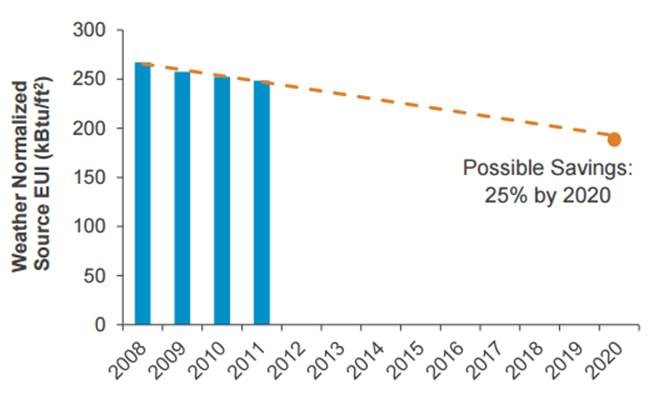
Expert Q&A: Keeping Track of Your Building’s Energy and Water Consumption Data
Urjanet Inc | May 23, 2016 | Energy & Sustainability
Keeping up with your property’s energy and water usage to comply with energy benchmarking and transparency laws or participate in voluntary efficiency programs like the Atlanta Better Buildings Challenge can be daunting. A massive amount of data has to be collected and properly entered into ENERGY STAR Portfolio Manager® in order for a building to compare performance with similar buildings locally and nationally. Building participants in the Atlanta Better Building Challenge and buildings required to comply with the Atlanta Commercial Buildings Energy Efficiency Ordinance use ENERGY STAR Portfolio Manager to track energy and water consumption. Juliette Apicella, Southface’s program manager serving the Atlanta Better Buildings Challenge, spoke with Urjanet to explain some of the ins and outs of tracking your data.
Q: Can you give some background on Southface?
JA: Southface was established in 1978 and focuses on promoting sustainable homes, workplaces, and communities. We primarily deal with the built environment on the residential, commercial, and municipal levels. We engage these markets by offering educational curriculums, training, and technical assistance. We are also active in research and advocacy work.
Q: Can you tell us about the building energy disclosure ordinance in Atlanta?
JA: The Atlanta ordinance passed by City Council in April 2015 is focused on promoting efficiency in commercial buildings through requirements for benchmarking energy and water use, reporting building performance and building assessments. The first phase of the ordinance requires buildings 50,000 square feet and larger to benchmark and report energy and water consumption data to the city. The next phase of the policy will include buildings 25,000 to 50,000 square feet. The City of Atlanta offered a training program to educate building owners on how to comply with the ordinance and how to use Portfolio Manager to manage and track energy and water consumption on the property. The City also set up a help desk to assist property managers and owners with benchmarking and reporting to meet the deadline.
Q: What is the Atlanta Better Buildings Challenge?
JA: The Atlanta Better Buildings Challenge (ABBC), launched in 2011 is a public-private partnership led by the City of Atlanta Office of Sustainability. The goal of this voluntary challenge is to reduce energy and water consumption in Atlanta’s commercial buildings by 20 percent by 2020. The ABBC is a top priority in fulfilling Mayor Kasim Reed’s vision of making Atlanta a top-ten sustainable city. The program is making measurable impacts on Atlanta’s energy and water use while supporting the local economy and building the clean energy industry. Atlanta is very competitive and is leading the nation with the largest participation totaling close to 104 million square feet of commercial buildings committed to the Challenge.
Q: How are building owners and property managers getting their energy and water data into Portfolio Manager?
JA: Many property managers and owners get their data from bills or utility websites: Atlanta Watershed’s WebConnect, their natural gas company’s website, and Georgia Power’s Energy Direct portal. They’re either downloading spreadsheets of the consumption and cost data or entering it directly into Portfolio Manager. Some properties in the ABBC have contracted with utility bill management services which collect billing data directly from utilities and upload the information to Portfolio Manager.
Q: What are some common mistakes Portfolio Manager users make within the application?
JA: The types of mistakes we commonly see range from data entry errors, gaps in data and incomplete data for reporting periods.
Q: Have you seen that some tenants resist providing their utility bill information for data privacy reasons?
JA: Yes, that is pretty common. I’d say it’s most challenging in the multifamily market. It’s more complicated when a building doesn’t have a master meter. It means that someone has to go and get permission to acquire and report on the data. Reaching out to residents to get that approval can be difficult and time-consuming. Some don’t always understand the reason behind the request.
Q: Do you think utilities will ever be required to make whole-building energy data available to owners?
JA: That’s not a question I can answer. There are several utilities providing data access to one degree or another. Some utilities are much more resistant than others.
For now, it would be a lot easier if utilities provided the data in a format that could be directly uploaded to Portfolio Manager. Building owners with large portfolios realize how much work it takes to clean and organize the data. We often recommend that building owners with many buildings in many different locations consider investing in a utility bill management service provider.
Q: What comparisons should building owners make when they are assessing their buildings?
JA: Once property managers and owners begin benchmarking their data in Portfolio Manager the metrics generated can be used to begin to assess the performance of a property. We recommend comparing a building’s ENERGY STAR score or energy use intensity (EUI) to the national median, which is the mid-point reference of the group of buildings with similar attributes such as building size and fuel mix. Another reference is the change in a building’s performance over time: reduced consumption as a result of efficiency projects or increases in energy or water use identifying the need for a building assessment to determine savings opportunities.

Buildings that consistently benchmark save energy. On average, a property benchmarking will see an average reduction in energy use of 2.4 percent per year and a two-point increase annually in ENERGY STAR Score. Maintaining these savings through 2020 could total approximately 25 percent.
This post was originally published on Southface’s Journal.
———
Want to learn more about energy benchmarking data challenges and opportunities? In a new eBook by Urjanet, with insights from the EPA, IMT, The Cadmus Group, and Southface, you’ll learn how to comply with building energy benchmarking and transparency laws and improve data collection and integration into Portfolio Manager. Download the eBook today!
Related Resources:
- How Blockchain Technology is Changing the Energy Market
- A Day in the Life of a Sustainability Professional
- Solutions Sheet: Utility Data for Energy Management & Procurement
If you like what you’re reading, why not subscribe?
About Urjanet Inc
Urjanet, the global leader in utility data aggregation, simplifies how organizations access and use utility data, enabling them to focus on their business. Our technology collects, processes, and delivers data from over 6,500 electric, natural gas, water, waste, telecom, and cable utilities worldwide.
You May Also Like
Support Business Continuity by Embracing ESG
Honor Donnie | March 18, 2022 | Energy & Sustainability
